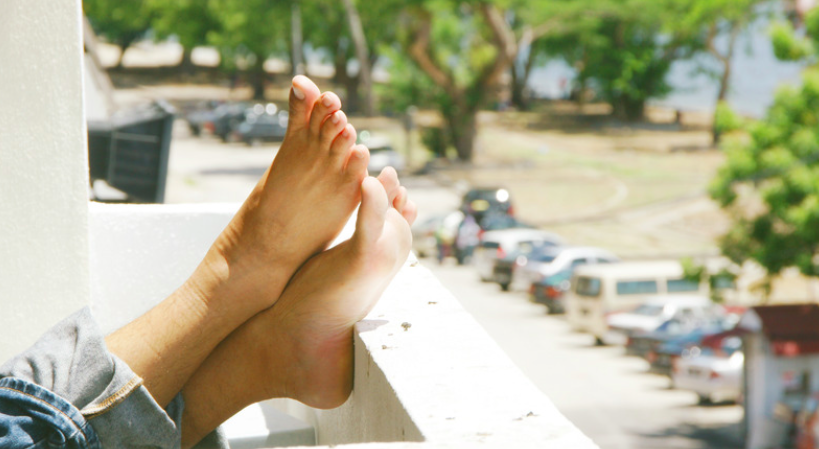Diagnosis and Treatment of Plantar Fasciitis in Wake County

What is Plantar Fasciitis?
The plantar fascia is the long, thin ligament that connects the heel to the front of the foot and lies directly beneath the skin on the bottom of the foot. The plantar fascia serves an important purpose – supporting the arch of the foot and encouraging normal foot mechanics during walking. Plantar fasciitis is the most common cause of pain on the bottom of the heel. This condition occurs when the plantar fascia becomes irritated and inflamed. Proper treatment for plantar fasciitis is crucial to maintaining proper foot health and living without pain and discomfort.

What Causes Plantar Fasciitis?
Too much pressure on the plantar fascia can damage or tear the tissues, causing heel pain, inflammation, and stiffness. In most cases, this condition develops without a specific reason. However, tighter calf muscles (which make it difficult to flex the foot and bring toes up toward the shin), obesity, a very high arch, repetitive impact activities such as running, or new or increased activity may play a role in the likelihood of developing plantar fasciitis.
Symptoms of Plantar Fasciitis
Being aware of the symptoms of plantar fasciitis is important, as this awareness can help you seek the proper orthopedic care. The most common symptoms of plantar fasciitis include:
- Pain on the bottom of the foot near the heel
- Pain with the first few steps after getting out of bed in the morning, or after a long period of rest, such as after a long car ride. The pain subsides after a few minutes of walking.
- Greater pain after (not during) exercise or activity
How is Plantar Fasciitis Diagnosed?
Your doctor will conduct a physical examination in order to diagnose plantar fasciitis. Your physician will check your foot for tender areas, and the location of your pain should allow them to determine its cause. In some cases, your healthcare provider may order an X-ray or MRI to make sure a stress fracture or other orthopedic injury is not present. However, imaging tests are not normally required to diagnose plantar fasciitis.

Treatment Options for Plantar Fasciitis at Raleigh Orthopaedic
More than 90% of patients with plantar fasciitis will see an improvement in their symptoms within 10 months of starting simple, conservative treatment methods. These techniques include:
- Rest: Decreasing or even stopping the activities that make the pain worse is the first step in reducing pain. Athletic activities where the feet pound on hard surfaces (running or step aerobics for example) may need to be stopped.
- Ice: Rolling the foot over a cold water bottle or ice for 20 minutes is effective. This can be done 3 to 4 times a day.
- Anti-inflammatory medication: Drugs such as ibuprofen or naproxen reduce pain and inflammation.
- Exercise: Plantar fasciitis is aggravated by tight muscles in the feet and calves. Stretching the calves and plantar fascia is the most effective way to relieve the pain that comes with this condition.
- Cortisone injections: Cortisone, a type of steroid, is a powerful anti-inflammatory medication. It can be injected into the plantar fascia to reduce inflammation and pain.
- Orthotics: Shoes with thick soles and extra cushioning can reduce pain with standing and walking.
- Night splints: Most people sleep with their feet pointed down. This relaxes the plantar fascia and is one of the reasons for morning heel pain. A night splint stretches the plantar fascia while you sleep. Although it can be difficult to sleep with, a night splint is very effective and does not have to be used once the pain is gone.
- Physical therapy: A physical therapy program may involve an exercise regimen focused on stretching the calf muscles and plantar fascia. It may also involve specialized ice treatments, massage, and medication to decrease inflammation around the plantar fascia.
In severe cases of plantar fasciitis, when nonsurgical options have not provided relief after 12 months, surgery may be considered. Surgery generally involves the release of a portion of the plantar fascia to decrease the pull on it. If your doctor at Raleigh Orthopaedic feels that surgery may be the best next step for you, they will walk you through your options and ensure that all of your questions about the procedure are answered.

Recovery from Plantar Fasciitis Surgery
Recovery from surgery for plantar fasciitis depends on the procedure you received. If you have undergone open surgery, you will likely need to wear a walking boot for the first two to three weeks after surgery to keep weight off the foot and protect it during the healing process. If you opted for endoscopic surgery, you will be able to put weight on your foot soon after surgery and you can wear regular shoes (as long as they fit properly). Most people return to normal activity between three and six weeks after surgery.
Prevention of Plantar Fasciitis
There are many lifestyle changes you can make to protect against the development of plantar fasciitis. Maintaining a healthy weight will keep pressure off the feet, which can reduce your risk of plantar fasciitis. Wearing comfortable shoes that offer support to the feet is also very important for your overall foot health. Try to avoid walking barefoot on hard surfaces, especially in the morning when plantar fasciitis is usually more prevalent. Finally, replacing high-impact exercises with more low-impact activities, such as swimming or cycling, is advised. You should always remember to stretch your legs and feet after a workout to avoid injury.

Learn More About Foot and Ankle Treatment at Raleigh Orthopaedic
Raleigh Orthopaedic is proud to be Wake County’s oldest and most experienced orthopedic practice. We offer our patients access to comprehensive foot and ankle care at our clinic locations throughout Wake County, and we want to help you address pain that may limit your daily activities. To schedule an appointment with one of our providers, please give us a call today or book online. We look forward to serving you!




